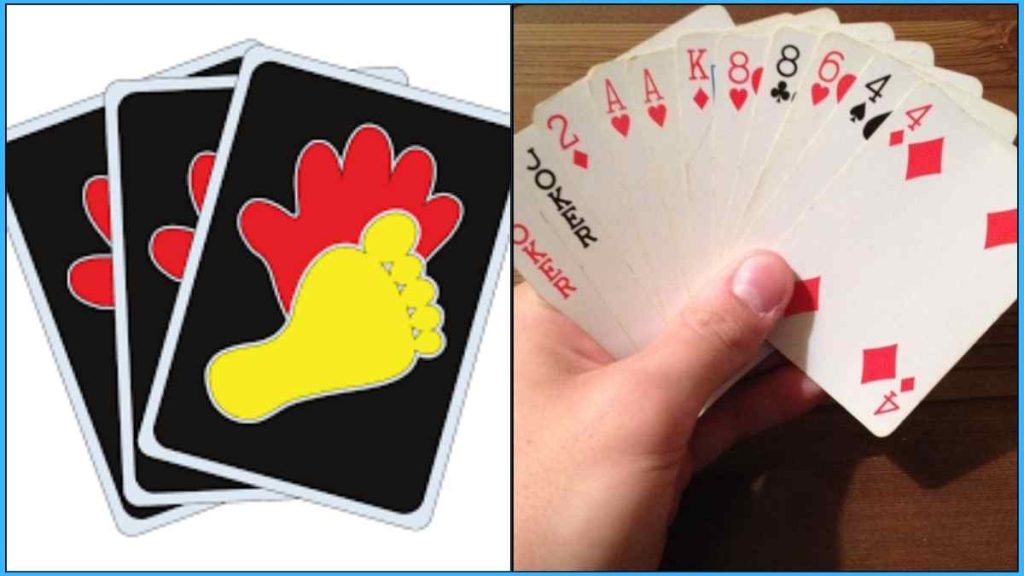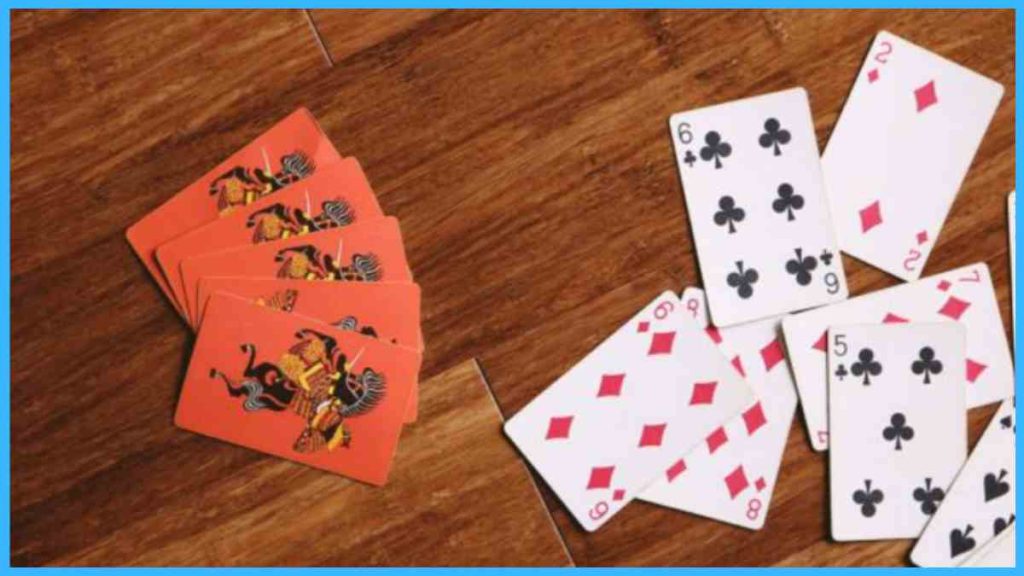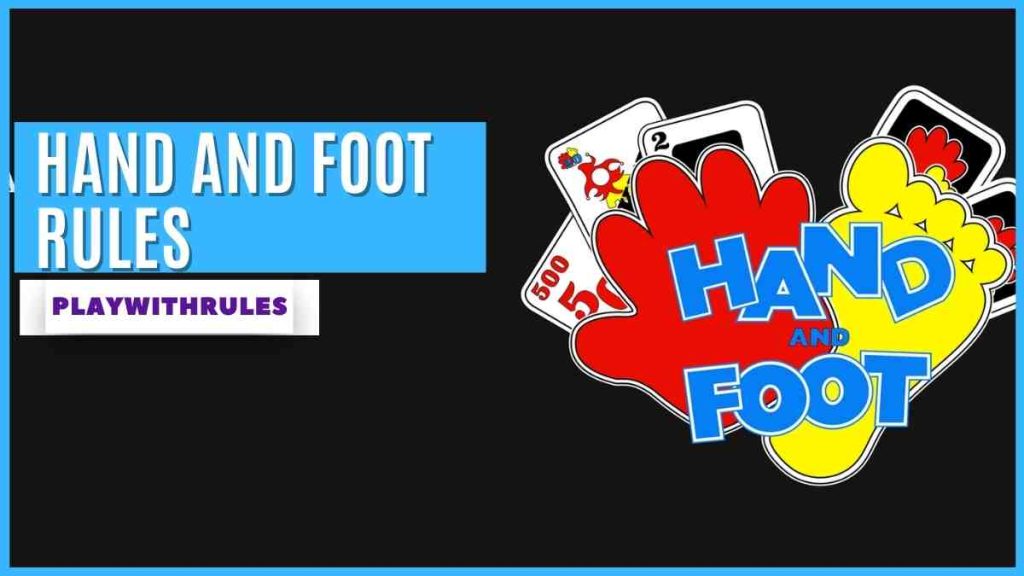Hand And Foot Rules 2024: Today, we are discussing a unique card game where you can team up with your friends! That’s right – a card game where you need to work with a teammate and engage in a battle of wits, strategy, and luck. The game we are talking about is the incredibly popular Hand and Foot card game. If you have always wanted to learn the Hand and Foot card game rules, then you’re in the absolute right place!
In this article, we will explain the game by breaking it down and simplifying it. We will elaborate on every minute detail so you can teach this to your friends in a matter of minutes! Ready to learn how to Play Hand and Foot with Rules? Let’s begin!
Table of Contents
How To Play Hand And Foot Card Game?
The core elements of the game are pretty simple. Rest assured – you will learn the game quickly. However, there are several complexities, and we will get into them later. But for now, let’s get a brief overview of how the game is played and how the hand and foot card game rules can help you win.
As mentioned earlier, this is a team-up game. You can choose a friend you want to team up with, and two other players will form the other team. There is no individual victory here – you must play as a team to win, and to do that, you need to create sets of cards before the other team does. That’s it! Sounds simple so far? Let’s proceed to the main game!
Objective
The primary objective of this game, to nobody’s surprise, is to win. Now, how do you do that? You need to coordinate with your teammate and create ‘Melds’ or sets that will award you points while playing by the Hand and Foot card game rules. The first player to have played all their cards finishes the round. But one thing to note here is that 4 rounds are played to determine the winner by tallying the scores accumulated at the end of the said 4 rounds.
Hand And Foot Rules
Now we get to the meat – the Hand and Foot card game rules and regulations. In this section, we will break down the entire game so that you can understand how the play proceeds, how to win, what is allowed and what isn’t. Without any delays, let’s get into it:
1. General Rules For Hand And Foot Card Game
- Players must create ‘Melds’ to win the game. Melds are stacks of cards of the same suit. A minimum of 3 cards of the same suit and a maximum of 7 cards of the same suit make 1 meld. A successful or complete meld has 7 cards of the same suit to be called a ‘book.’
- Each turn begins with a draw. The players can draw from the discard pile (must 1 card) or the drawing pile (must draw 2 cards). However, if a player draws from the discard pile, they need to be able to make a meld with the top card of that pile.
- When a player has put down all their cards from the ‘Hands’ stack, they can pick and start playing with their ‘Foot’ stack, according to the rules of hand and foot.
- One player from each team will be creating the melds on their side.
- A player’s turn ends with them discarding one card and adding it to the discard pile. This has to be repeated for each player during their respective turns.
- According to the official Hand and Foot card game rules, four rounds make one game. Ultimately, the team with the most points (we will explain how to calculate these points later) wins.
- A player must finish playing all their ‘Hands’ cards before they can play with the ‘Foot’ stack. Once the ‘Hand’ stack is completely used up, players are allowed to look at their ‘Foot’ stack.
- A player can only end a round and get rid of all their cards if their team has one clean meld and one dirty meld and one player is playing using their ‘Foot’ stack.

2. Melds
- Hand and Foot card game rules state that players are allowed to lay down as many melds as possible. Teammates can help each other out by adding to the melds. However, they must wait for their respective turns.
- Melds can only be made if they are of a certain value. This value keeps changing per round. For example, players need 50 points in card value in round 1 to create a meld. In rounds 2, 3, and 4, they need 90, 120, and 150, respectively.
- Melds can be created with a minimum of 3 cards and a maximum of 7 cards.
- There are two types of melds: clean melds and dirty melds. A clean meld is a meld that has no Wild Cards (let’s say seven 3s straight). A dirty meld is completed using one or more Wild Cards. In short, 4 natural cards and the remaining Wild Cards.
- A clean, complete meld is stacked and kept to the side with a red card on top. A dirty, complete meld is staked and kept aside with a black card on the top.
3. Wild Cards
Just when you thought things couldn’t be more interesting! Here are the Wild Cards in Hand and Foot and their individual functions or roles in the game:
- According to Hand and Foot rules, 2s and Jokers are wild cards.
- These cards can be added to any meld to complete them. For example, if you have five 6 numbered cards and two 2s or two Jokers or one Joker and one 2, you can use these Wild Cards to complete the meld of ‘6.’
- You cannot create a dirty meld where the number of Wild Cards exceeds the actual cards. In other words, you cannot complete a ‘3’ meld using 5 Wild Cards and two 3s.
4. Special 3
The 3s also have special powers in this game, but the power depends on whether it’s a black 3 or a red 3. Here’s what you need to know about them:
- If a red 3 is picked up, it must immediately be played.
- If a red 3 is picked up and played, the player needs to draw one additional card for each red 3 played or picked up.
- Red 3s can be used to create melds.
- Black 3s cannot be used to create melds. They can only be used to block the discard pile. In other words, players are not allowed to draw from the discard pile if the top card is a Black 3.
5. Discard Pile Rules for Hand And Foot Card Game
- Players can draw from the discard pile if the top card is used to make a meld.
- If a player draws from the discard pile, they need to collect 7 cards (including the top card).
- Hand and Foot card game rules state that if the discard pile has less than 7 cards, the drawing player must take all the cards from the discard pile.
- If the discard pile has a Black 3 as the top card, players are not allowed to draw from the discard pile. However, at the end of their respective turns, they can discard one card that will become the top card of the discard pile. This card can be any card from their hand or foot.
Deal & Setup
The first step is dealing with the cards and setting up the game. Here’s all you need to know about dealing and setting up:
- The game is usually played between pairs—4 players, 6 players, etc. Then, two teams are created (let’s say 4 players are playing), each team consisting of 2 players.
- This game requires five decks of cards (52 cards for each deck X 5 = 260 cards total).
- 10 Jokers are needed (2 per deck) in total.
- The dealer is selected randomly, upon mutual agreement, or via a coin toss, as per rules for hand and foot.
- The dealer then shuffles all 5 decks of cards (260 cards) and starts dealing one card to each player (one at a time).
- In Hand and Foot, each player has to play with two decks of cards of 11 cards each (22 cards total). The first stack of 11 cards is called ‘Hands’ while the next set of 11 cards is called ‘Foot.’
- According to hand and foot rules, players can look at their own ‘Hands’ stack and arrange them however they see fit. However, they cannot look at their own ‘Foot’ stack. It has to be kept aside, face-down. This deck is saved for later parts of the game.
- Once the dealing is done, the rest of the deck is kept at the centre of the table. This becomes the drawing pile. Then, the top card from that pile is flipped over (face-up), creating the discard pile.
- The play begins with the player to the left of the dealer. According to the hand and foot card game rules, the game must start clockwise.
Card Values
If you think winning will be easy, let us tell you – it might be more challenging than you have pictured! This is because each card has a value, and the scores are tallied at the end of 4 rounds. The card values are as follows:
- Jokers: 50 points each
- Aces: 20 points each
- 2s: 20 points each
- 8s – Ks: 10 points each
- 4s – 7s: 5 points each
- Black 3: 5 points each

Scoring
The scoring system, as per the hand and foot rules, involves calculating the scores from different aspects of the game. Various criteria are assessed at the end of the game, and a score is added for each criterion. Let’s understand the scoring system in Hands and Foot:
- First, the card values are taken into account. However, each team is awarded points only for the melded cards.
- The total value of each player’s cards at the end of the game counts for negative scores for that team. For example, if a team is left with two 8s and one 4, 25 (10 points each for every 8 and 5 points for one 4) will be subtracted from their total score.
- Clean melds are worth 500 points each, while dirty melds are worth 300 points each. These will also be added to the scores.
- Every red 3 is worth 100 points per the Hand and Foot card game rules.
- The team whose player ‘went out’ first, i.e., finished playing all their cards from the hand and foot deck, will be awarded 100 points for going out.
- If your opponent finishes a round first, before you get to your ‘Foot’ cards, and you have a red 3 in your ‘Foot’ stack, your team loses 100 points.
Winning
A game of Hand and Foot goes on for 4 rounds. At the end of 4 rounds, the total scores are tallied as per the Scoring criteria. Then, the team with the highest point wins. Finishing first should be the motive, but play wisely to acquire the maximum score. The point is to win the game, not the rounds.
Hand And Foot Variations
Let’s say you have been playing Hand and Foot for a while now and find yourself growing out of it. What do you do? You introduce a few variations in the game to spice it up! Here are some of the most popular variations of the Hand and Foot card game that you must try:
- 26 cards – Usually, each player is dealt 22 cards in total – 11 hands and 11 feet. To make the game slightly more interesting, add up the number of cards each player gets. In this variation, each player gets 26 cards – 13 hands and 13 feet.
- Allow Wild Books – Wild Handbooks are basically melds where all 7 cards are wildcards. Now, there are differing schools of thought on whether this should be allowed or not so you can choose to follow whichever rule you think fits your playing style best. Allowing wild books will certainly make things far more competitive. To add to that, you can introduce another rule that states that a Wild Book cannot be the first meld of any team.
- Going Out – A team usually requires 1 clean meld, 1 dirty meld, and a teammate who is playing from their foot stack. You can alter this a little bit. For example, the new rule can be that a team or a player of a team must have 2 clean melds and 2 dirty melds to be able to go out.
- Teammate’s Permission – Another interesting rule you can imbibe is asking your partner’s permission before ‘going out.’ For example, if you have played your cards and discarded the last one and are ready to go out, you must ask your partner for permission before going out. However, your partner has the right to refuse. This means you will have to stay in the game for longer.
Did You Know?
- The Hand and Foot card game is well-liked by the Rummy family.
- Although unclear, it is believed that the game originated in Northern America during the mid-20th century.
- Initially, there were no binding rules for the Hand and Foot card game. This led to the game evolving, encompassing different rules and nuances. While this made it challenging to stick to one principal school of rules, it allowed different variations to evolve.
- Hand and Foot also has a digital adaptation, which is available in different formats.
- Games like Samba and Canasta have played significant roles as influencers or inspirations for Hand and Foot.
FAQs
How many decks of cards are needed to play Hands and Foot?
Typically, 5 decks of cards are required to play a game between 4 players (2 teams). However, if you want to bend the rules a little, you can.
What happens if a player cannot make a move in the Hand and Foot?
According to the Hand and Foot rules, if a player is all out of viable moves, they must end their turn by discarding one card. However, they must pass their turn if they cannot discard the card they are left with.
How does scoring work in Hands and Foot?
A number of factors are factored in when calculating the score in Hands and Foot. Some of the factors that affect the scores are the card values of the melds, the type of melds (clean or dirty), the cards left in hand (negative scores for each), red 3s, etc.
When can you pick up the Foot cards?
A player can start playing their foot cards only after they have played all their hands cards.
What are Wild Cards in Hands and Foot?
The Joker cards and the 2s are considered wild cards in the game. These can be added to any melds to complete them.
Conclusion
Fun, tactical, competitive, and unpredictable – Hands and Foot has all the makings of a great card game. No wonder it is a favorite card game across North America. Hand and Foot is played in many households before bedtime as a recreational activity for families. But don’t forget to stick to Hand and Foot card game rules, while trying to win the game.
Now that you know all the rules for Hands and Foot, you are ready to take on your next challenge. How about we learn the rules of Bs Card Game? Let’s go! Stick with Play With Rules to learn about new games and more.

